The front door is a real focal point of the home and is often the first thing to greet the eye. You can make a visual statement by choosing a shade that sets the tone for your home. It’s also important to follow the correct painting procedures for maximum impact.
When it comes to deciding on the colour of your front door, it often comes down to personal preference. But it is also worth considering colours that complement your existing home exterior and brickwork.
Whether you choose a bold colour, a subtle shade or a unique design, the final effect should welcome you home everyday.
Explore our inspiring exterior schemes for front door inspiration.
A Guide To Painting Your Front Door
Follow our step-by-step instructions to learn the process of painting different types of front doors.
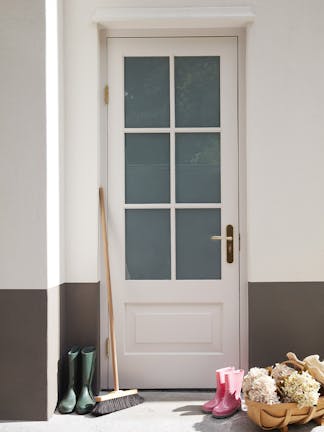
Which paint finish should I select to paint my front door?
Our water-based Intelligent Exterior Eggshell and Intelligent Gloss provide a robust and durable finish, perfect for front doors. They are easy-to-apply, quick drying, with very little odour, and are available in all Little Greene shades.
Intelligent Gloss has a sheen level of 87-90% which looks really smart, particularly in darker shades like Dock Blue or Basalt. With a sheen level of just 15%, our Intelligent Exterior Eggshell is perfect for those wanting a flat finish.
Browse our Intelligent Exterior Eggshell and Intelligent Gloss.
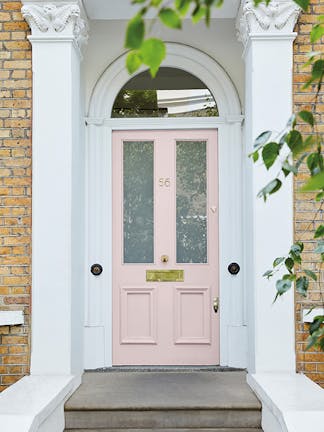
What do I need for painting a front door?
After choosing an appropriate paint finish, you will just need a few items to prepare for painting the front door:
- A quality primer - we recommend using our Intelligent ASP (All Surface Primer)
- Little Greene exterior paint, such as Intelligent Gloss or Intelligent Exterior Eggshell in your chosen shade
- Dust sheets
- Medium grit sandpaper
- Screwdriver or drill
- Good quality paint brush
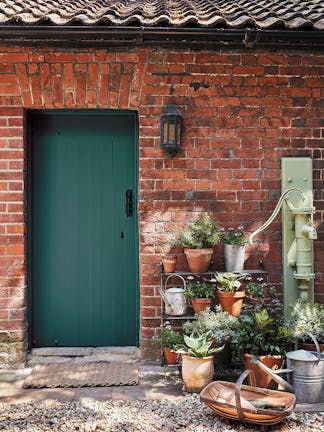
How to prepare a wooden front door for painting
1. To begin, remove all fittings from the door, such as the door handle and locks.
2. Sand down the door with a medium grit sandpaper. This process will remove any sheen or loose paint.
3. Clean the door using a soft cloth to remove any remaining dust.
4. Apply one coat of Little Greene All Surface Primer and allow to dry.
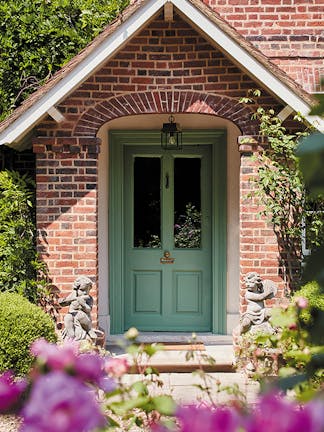
How to prepare a uPVC door for painting
The steps for painting a uPVC front door are similar to painting a wooden one.
1. Remove any flakes from the door and fill any holes or previously damaged areas.
2. Apply our Intelligent ASP (All Surface Primer) to give your door extra protection and depth of colour. Once dry, add a second coat of Intelligent ASP.
3. Follow our guide to painting a panelled or flush front door below.
You can find the technical data sheets with full preparation instructions here.
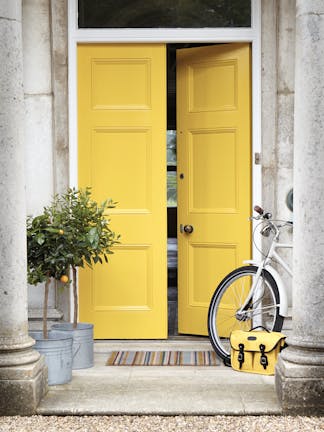
How to paint a panelled front door
1. Choose a good quality paint brush for painting a panelled door. Your brush is extremely important to ensure a professional and high quality finish.
2. Apply the desired paint colour in the direction of the grain to avoid streaking.
3. Paint the door in sections, starting with panel mouldings first, followed by the inner panels.
4. Next, paint the centre stile and then the horizontal panels (or cross rails).
5. Finish by painting the outer panels and lastly, the edges of the door.
How to paint a flush front door
1. Paint flush front doors in sections to maintain an even look.
2. When each section is complete, use horizontal strokes to blend the painted sections together.
3. Remember to keep the edges wet. If the area is allowed to dry before blending, the job will look uneven and messy.
Top tip: Working in small, sectioned-off areas will ensure the best finish.
For tips on refreshing exterior fences, tables and chairs, read our guide to painting outdoor woodwork.
Choosing a Front Door Paint Colour with Our Creative Director, Ruth
Our Creative Director, Ruth Mottershead, answers some of your most frequently asked questions about front doors. Read her expert guidance on choosing the ideal front door colour to create a warm welcome.
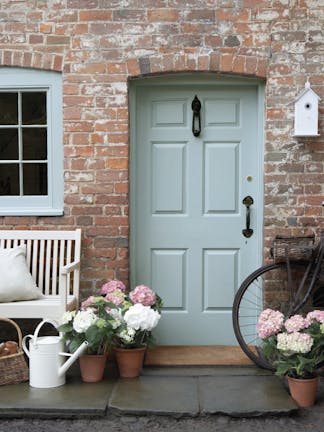
Which are the most popular colours for front doors?
For something dark, Ruth suggests an off-black or a dark blue such as Basalt: “Elegant and sophisticated, it pairs beautifully with brass furnishings.”
Another favourite is Celestial Blue. Ruth says, “this colour is one of the oldest on our colourcard, originating from 1807. A delicate, soft blue, it is an excellent companion to red brickwork or stone for more of a country cottage scheme.”
“A really bold, confident green is a really comfortable colour to use outside. Harley Green works well here, as we are surrounded by green in our natural environment.” Consider choosing a contemporary green shade that mirrors its outdoor location.
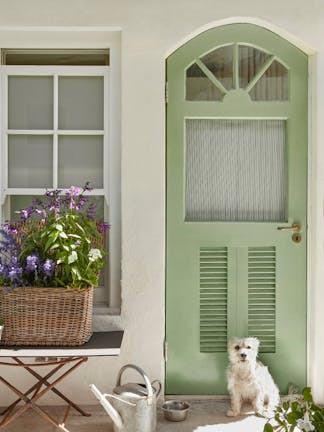
What colour should I paint my front door?
Ruth adds that selecting the right front door shade can have a real impact on your home: “Your front door is the lipstick of your home. It’s a smile on the front of your house, so selecting a front door colour is certainly an important decision. Your front door is the first glimpse of your personality that visitors will receive.”
If you’re looking for something dark and smart, Ruth suggests using off-black shade. Or for something bright or playful, consider reds or bold blues such as Smalt and Woad.
To inject a little personality into your outdoor scheme, use the bright, impactful Mister David. Ruth advises: “This yellow paint certainly makes a statement and will put a smile on the face of your guests and passers-by.”
According to Ruth, a classic option would be mid-strength colours. Muted pastel tones, such as Aquamarine are perfect for a restful finish.
Ruth adds: “For a really bold contrast, select a white or a neutral tone. Shirting or Loft White will stand out against dark facades.”
How can I choose a colour that works with accessories on my door?
Ruth says: “For chrome accessories, consider more fun, pastel colours such as Light Peachblossom and Boringdon Green. If you prefer more traditional brass door furnishings, select darker tones such as Lamp Black, Obsidian Green or Basalt.”
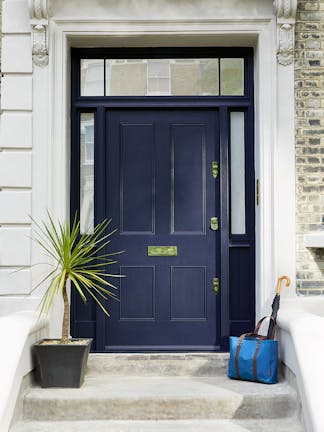
How can I make sure that the front door complements the rest of the house?
Ruth says: “When thinking about which colour to select for your front door, there are a number of considerations. The first is the brickwork or render, has the house been previously painted? Is there a colour within the brick that you can pull out and coordinate with your front door? Many of our homes are stone-based tones and warm neutrals work well with these.”
Try Hammock, which sits really comfortably alongside Bath Stone. Or for something more playful, try Canton. If you want to create a sophisticated smart look, try Basalt to provide a strong contrast.
To complement darker tones, Ruth suggests a soft blue such as Bone China Blue. She adds: “If your home is painted white or off-white, a monochromatic scheme provides a contemporary, harmonious finish. Consider using ‘Jack Black’ or ‘Obsidian Green’ on your doorway.”
Finally, for accompanying red brick buildings, she recommends an impactful, bold green like Harley Green. This natural shade pairs really well with warm red tones.
Request a complimentary colourcard to help find the right shade for your front door.

